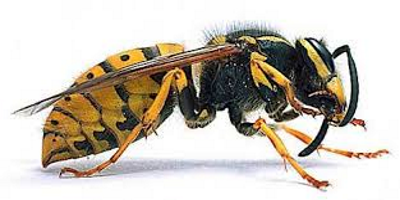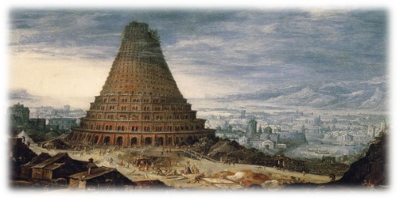In Deut. 7:20, the aide God promised to give the Israelites in order to conquer the giant Canaanites is often translated as a “hornet,” which some people interpret metaphorically to mean fear, dread, or panic. The only problem is that the Hebrew word translated as “hornet,” צרע, does not have any connection to the insect family, so the derived meaning of terror from it is questionable. Given the puzzling translation of “hornet” in Deut. 7:20, perhaps it's uncertain etymology points to an evolved form where the letter צ has replaced an older form with the letter ז. Changes between these two letters can be seen elsewhere in the Hebrew language. For example, Benner argues that צהב, meaning “yellow,” has no connection to its parent root צב, meaning “wall,” but rather is an evolved form from זהב, meaning “gold” (Changes in the Hebrew Alphabet). These types of changes likely occurred because the sounds of צ (ts) and ז (z) are similar. We may also note that some Hebrew words that are spelled with צ (ts) are actually translated as though they had the letter ז (z). Note that in Judges 19:41, the word, צרעה, is translated as Zorah—just another indication that when a צ is spotted, in some cases, it should be treated as a ז. So, evidence will be presented here that צרע is really an evolved form of זרע by examining the related meanings of each family to which these words belong. The contexts of the Exodus and the Conquest will also have to be explained to identify a word to suggest a logical alternative to “hornet.”
But first, let’s consider the unfit nature of the rendering of “hornet” for the evolved form, צרע. The Hebrew meaning of צרע is a skin disease or leprosy, and the translation of “hornet” from this seems a stretch. What kind of “infection” does God send in the record we have of the Conquest of Canaan? It seems, דבורה, the Hebrew word for bee or wasp, would be sufficient to communicate the idea of a hornet, if that were the intended meaning in Deut. 7:20. Also, other Hebrew words sharing the root of דב relate naturally to a wasp, such as דבשׁ, meaning honey. Yet no words connected to צרע seem to relate to a hornet. Do the related words of צרע with the root צר give us any clues as to what “hornet” might mean in the context of the Conquest? Consider that צרב means burn or scorch, צרה is a balsam (to place on a burn), צרף communicates the ideas of smelt, refine, test. All these words seem to be related to heat. Even the word צרח, which means roar, may be thought of as a sound with a lot of heat. From this we can see how צרע is connected to this family, for leprosy looks like skin that has been damaged or swollen; and modern science itself is discovering how much disease of the body is related to inflammation, which is excessive heat. However, the idea of a “hornet” doesn’t seem to naturally fall within the semantics of this family.
Unfortunately, noting the appearance of “hornet” found in two other places, does not suggest any logical relation of it to צרע either. The first occurrence in Ex. 23:28 says, “And I will send the hornet ahead of you to drive the Hivites, the Canaanites, and the Hittites out of your way.” We noted above that words with the צר root are connected to some idea related to heat or burning. So in Ex. 23, is God promising to inflict the Hivites or Hittites with a skin disease or fire in the Conquest? No. We do not have a record of such plagues taking place when Israel fought the Canaanites. Also, some places were burned, but these burnings occurred after the people were destroyed; so, these fires were not the agent driving the people out, as was the task of the “hornet.”
The other place the word “hornet” appears is when Joshua reviewed the significant events of the Conquest, which included God’s sending of the “hornet” against two Amorite kings: “I sent the hornet out ahead of you, which drove them [the Canaanites] out before you—also the two Amorite kings. You did not do it with your own sword and bow (Josh. 24:12). The Hebrew is ambiguous for that verse, so translations vary, but there is no context of infection or scorching given; rather, it is related to activity against the Amorites. How, then, do we bring together the fact that the “hornet” went against the Hivites and Hittites in Ex. 23:28 and the Amorites in Joshua. 24:12?
There is one instance in the Conquest that involved both the Amorites and Hivites—when the Amorites attacked the Hivites after they deceived Israel and entered into a covenant with them. But in that battle, there were 5 Amorite kings (Josh. 10:5), not two, as noted in Josh. 24:12. Perhaps in Josh. 24:12, the Hebrew word שׁני, translated as “two,” with a consideration of different vowel pointings, might be taken to mean “second”—that the “hornet” went against the Israelites’ second encounter with a group of Amorite kings, but this time their defeat was not achieved with sword or bow, as in the first case (Num. 21:21–35), but with hail. Whatever the accounting is for the number of kings, this battle between the Amorites and Hivites included the notable event of the sun and moon standing still. It seems that if Joshua was going to highlight events of the Conquest, he would not fail to mention the battle where this miraculous event took place, and how the “hornet” worked in that battle. Whatever the idea of “hornet” is, it seems to indicate a circumstance in which military might would not be used to conquer these kings, and this was the one battle where this took place. Not only did the sun and moon stand still, but larges stones poured down from heaven. It is this idea of hail which I believe gives a clue to a different interpretation for צרע as an evolved form of זרע, which can give us an alternative meaning for the word “hornet.”
Hail comes from precipitation in clouds. The Cloud was significant in the Exodus. Recall in Ex. 14:20, the Cloud was giving darkness to the Egyptians, and light to the Israelites. In Ex. 14:25, God looked down from the Cloud to throw the Egyptian army into confusion, and to clog the wheels of the chariots (Septuagint and Syriac versions), presumably with mud and sand, since in darkness, the ground would have been wet, while the Cloud’s light for the Israelites would have dried the land, enabling them to walk on dry ground. Deut. 1:32 says that it was the “Lord your God, who went ahead of you on your journey, in fire by night and in a cloud by day . . .” This Cloud later filled the tabernacle: “Then the cloud covered the tent of meeting, and the glory of the Lord filled the tabernacle” (Ex. 40:34). Yet during the Exodus and in the wilderness journey, God was also present in the heavens above the Cloud.
This brings me to the idea of divisibility and yet oneness in the concept of God’s nature, as illustrated by blood and water being plural in Hebrew. Understanding this divisibility will be necessary to understand certain aspects of the Conquest that would suggest a different root for the word translated as “hornet.” So, I will explain this concept and return to the discussion of hail and the Cloud.
Blood and water occur in the plural because they are types of divisible unities. In Gen. 21:19, Hagar is described as finding water in this way: “Then God opened her eyes and she saw a well of water (literally waters). So she went and filled the skin with water (waters) and gave the boy a drink.” Both blood and water have “one substance” that can be divided, but the substance resulting from the division is no different from the substance prior to any division. Whether water is collected together or sprinkled in many drops, it is all still nothing but water. In a similar fashion, though God appears to be divided so as to take different identities for different roles to accomplish the task of the Exodus, the “divine substance” of each identity is no less divine even though their identities can be distinguished separately. Just as with blood and water, a divisibility of God is present in the Exodus itself, and this may be why David, when referring to the Exodus could use a plural verb with Elohim with reference to the God of Israel, and not pagan gods (2 Sam. 7:23).
In the Exodus, the presence of God in the cloud did not work alone. There was also an Angel of the Lord who worked with the Israelite troops on the ground: “Then the angel of God, who had been traveling in front of Israel’s army, withdrew and went behind them” (Ex. 14:19). This angel with the Name of God is also referred to as God’s presence who would go with them to capture the Canaanites: “I will send an angel before you and I will drive out the Canaanite . . .” (Ex. 33:2), and this angel seems to be equated with God’s presence a few verses later in the same chapter: “My Presence will go with you, and I will give you rest” (v.14). Isa. 63:9 speaks of the “Angel of His Presence” who saved the Israelites. Jumping to Judg. 2:1–5, the Angel of the Lord travels from their military base camp in Gilgal to Bochim and here is what transpired:
THE ANGEL of the Lord went up from Gilgal to Bochim and said, “I brought you up out of Egypt and led you into the land which I have sworn to your fathers; and I said, ‘I will never break My covenant with you, 2and you shall not make a covenant with the people of this land; but you shall break down their altars.’ Yet you have disobeyed me. Why have you done this? 3Now therefore I tell you that I will not drive them out before you; they will be thorns in your sides and their gods will be a snare to you.’ 4And it came about when the angel of the Lord had spoken these things to all the Israelites, the people wept aloud, 5and they called that place Bokim. There they offered sacrifices to the Lord.
Notice that this “Angel” claimed both to have brought them up out of Egypt and to have made a covenant with Israel, which will not be broken. This covenant was distinguished from covenants made with humans in the land the Israelites were conquering. This Angel was sent to help them possess the land, but because of their disobedience, he withdrew. This “Angel” was worshipped by the Israelites, and the sacrifices the Israelites offered to him were described as being offered to the “Lord.” The place was called Bokim, which means worship, because by offering these sacrifices they were worshipping this “Angel,” yet the Israelites were not condemned here or anywhere else for worshipping this being, which would be the case if this being were some kind of idol or heavenly being who was not God. The first of the ten commandments also forbids any worship of angels.
Apart from the Angel of the Lord, and the Cloud, there was a presence of God in the heavens who actively worked on Israel’s behalf by causing the Sea to part when Moses lifted his hand (Ex. 14:21). When we look at the Exodus, we can identify three separate presences of God, each having a different role in aiding the Israelites in escaping the Egyptians and crossing the Red Sea, and this same divisibility can be seen in the Conquest. Let us now compare the two.
Since both the Cloud and the Angel of the Lord worked together in the Exodus, it seems that they both would be working together in the Conquest. Just as the Angel of the Lord would go before them into Canaan, so would the Cloud. I believe the Cloud, according to my Christian understanding, would be the Holy Spirit. Remember, the idea behind the word mistranslated as hornet, carries the idea of military defeat without the use of weapons. Because the Angel of the Lord was armed, the supposed “hornet” who was sent with the Israelites into the Conquest cannot be a reference to the Angel of the Lord. We know the Angel of the Lord was armed since angels can take the form of humans (Heb. 13:1), and the “man” appearing armed before Joshua commanded Joshua to take off his sandals because he was standing on holy ground, just like Moses before God in the burning bush (Josh. 5:13–15). Thus, it was the presence of God in the Cloud, the Holy Spirit, who did not use a weapon, but showered down hailstones on the Israelites in the battle against the Amorites. This same Cloud (the Holy Spirit) is distinguished from the Angel of the Lord (pre-incarnate Jesus in Christian terms), and God the Father in heaven in both the Exodus and Conquest.
This perspective of the Conquest now allows a new candidate to emerge that perhaps could not have been seen by only appealing to the language itself; one who is more suitable to the context and more firmly confirmed on linguistic grounds. If Benner is right about the evolution from zayin (ז) to tsadeh (צ), the linguistic analysis of Deut. 7:20, in which צרע can be traced back to a prior זרע, opens the possibility that this verse is speaking of God promising to send the Holy Spirit, not a hornet, into the Conquest. Evidence for this may be obtained by noting the זר family of words has much in common with the entire biblical description of the Holy Spirit. When we examine the family of words with זר, we find that זרר means to sneeze, a forceful gush of wind, which has affinity to the Spirit, because in Hebrew, Spirit also means wind. The word זרת means shining or flashing light, reminding us of the Holy Spirit in the pillar of fire and later as the glory of the Holy Spirit that shone in the temple. The word זרב, the verb form used only in Job 6:17, is a reference to drying up of streams which prevents their flowing, and since the Holy Spirit is likened to living water (John 7:38–39), זרב actually presents a negation of an element associated with the Spirit. Not surprisingly, זרם refers to pouring forth in floods, a down pour; and זרף to dripping or irrigating.
Let’s remember the Holy Spirit also has a didactic role in relation to humans in the Scriptures. For references related to the Spirit teaching, consider, Neh. 9:20, which says, “You gave your good Spirit to instruct them [the Israelites].” In Ezekiel 36:26–27, the role of the Holy Spirit is to cause people to walk in the ways of God, and the New Covenant says the way the Spirit does this is by renewing our minds with knowledge (Col. 3:10), with teachings from the Spirit, who breaks down the spiritual meanings of God’s words in our heads so that we can understand them (1 Cor. 2:12–13). In the song of Moses in Deut. 32:2, God’s words are described as dropping as rain, and the speech as dew, making an association between the Spirit’s role of instruction and water. We may note that זהר means to instruct, teach; and זרח means dawning, shining, with the idea that light can often mean a reference to enlightenment. And זרק can refer to both pour or scatter. Even the idea of scattering or sowing seed, expressed by זרע, carries the idea of not only reproduction, but planting seeds of knowledge in someone’s heart. So, we should not be surprised that the alternate meaning for זרע of arm, shoulder, strength, power, would be connected to the Holy Spirit, as the Spirit’s means of enlightenment is also the power we have to resist sin. From this analysis, we can see that all the related root words for the parent root of זר have associations with wind, light, water, and teaching, all of which are associated with the Holy Spirit in both the Old and New Covenants made with Israel. It is the Holy Spirit who is the common thread that can tie all the various words of the זר family together.
To further corroborate that זרע is likely a reference identifying the sending of the Holy Spirit, and not hornets, to aide the Israelites in the Conquest, let’s examine the idea of the Holy Spirit in relation to the meaning of זרע itself. According to the BDB lexicon, זרע has two sets of meanings: (1) sow, scatter seed and (2) arm, shoulder, strength. It is interesting that זרע, if evolved into צרע in Deut. 7:20, has a prefixed definite article and a feminine ending: הַצִּרְעָה. Going back to the unevolved state, the letters would be הזרעה. The word זרע with an “a” vowel means seed, descendants, or offspring, which can only be produced by means of a woman. If זרע is taken to have an “o” vowel (וֹ), it would form the Hebrew word זרוֹע, which means power, force, arm. So if זרע is a possible alternate spelling of צרע, then we may chose זרע with the o vowel indicating a reference to a specific divine Power, which is feminine. Thus, Deut. 7:20 may actually establish a second line of evidence that the Holy Spirit presented in the Old Testament is feminine, in addition to personal references to the Spirit, using the term ruach, which is also feminine. Thus, our mystery word הַזּוֹרעָה of Deut. 7: 20 may be translated as: “Moreover, the Lord your God will send the Power against them, until those who are left and hide themselves from you perish.” We might now view that God sent not a hornet, but “the Power,” the feminine power of God, God the Mother. Again, if we consider the word translated as “Power” as a reference to the Holy Spirit, it easily explains why this word has a feminine ending, since the person of the Spirit is feminine in Hebrew.
Not only can we see the Holy Spirit working in both the Exodus and the Conquest with the Angel of the Lord, but it may be argued that the same function said of the Cloud in the Exodus is also true of the Power in the Conquest. Note in Ex. 14:23 that the Cloud threw the Egyptian army in confusion in the Exodus, and in Ex. 23: 27–28, in reference to the Conquest, the “hornet” is prophesied to later cause confusion: “I will send my terror [feminine] ahead of you and throw into confusion every nation you encounter. I will make all your enemies turn their backs and run. I will send the hornet [the feminine Power] ahead of you to drive the Hivites, Canaanites, and Hittites out of your way.” If the Power is parallel to the Terror, also feminine in the Hebrew, then the Power, also working as the Cloud, is said to have been involved in the same activity of confusing Israel’s enemies. Since the Holy Spirit has the ability to enlighten and clarify, we should not be surprised that she may also perplex and bewilder.
Thus, upon examining the family of meanings related to both זרע and צרע, it is not unreasonable to suggest that צרע is an evolved form of זרע, which can be translated as the Power, the divine feminine power of God, and so constitute and important reference to contribute to our understanding of the Holy Spirit in her own person and as part of the divisible unity of God presented in the Old Testament, working in conjunction with the Angel of the Lord and God the Father for Israel’s benefit.

Like what you’re discovering? Continue the journey from Bible reader to translator.
|






